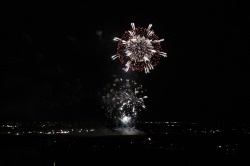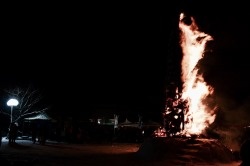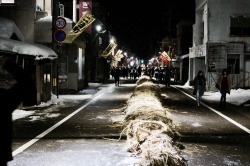About Daisen
Daisen is a granary region covered in lush mountains and rice fields situated in the south of Akita. The surrounding mountainous landscape changes dramatically season to season and the area supports a long history of local events, traditions and festivals. Known as Hanabi Town and famous for the annual national fireworks competition, Omagari Hanabi, Daisen boasts a display for every month of the year.
This page features a collection of articles written by current and previous members of the Daisen City Board of Education team, sharing some of their favourite places around town. Hopefully their stories provide some insight into what life is like in rural Northern Japan.
Life in Daisen
Life in Daisen — Andrew Mowle
2017-09-01
As Daisen is a relatively new city, I was unable to find a lot of information on it before I moved here, so I was a little nervous. Once arriving, however, I realized that because Daisen is made up of many smaller towns, it draws on parts of each of those towns to help define it. The thing I love the most about living in Daisen is how many different communities and events there are all year round.
I live and teach in Omagari, as well as in Nangai, so I see two very different parts of Daisen quite frequently. Even though my two main schools are only 10 minutes apart, the students, and the atmosphere around the school couldn’t be any more different. I’ve also had the chance to visit schools in the other towns (Heiwa, Kyowa, Ota, Nakasen) and each of these schools have their own individual characteristics as well. These differences help make each of the schools special, and expand to the communities around them.
A few of my favorite experiences in Daisen so far would be the festivals, both in summer and winter.
I live and teach in Omagari, as well as in Nangai, so I see two very different parts of Daisen quite frequently. Even though my two main schools are only 10 minutes apart, the students, and the atmosphere around the school couldn’t be any more different. I’ve also had the chance to visit schools in the other towns (Heiwa, Kyowa, Ota, Nakasen) and each of these schools have their own individual characteristics as well. These differences help make each of the schools special, and expand to the communities around them.
A few of my favorite experiences in Daisen so far would be the festivals, both in summer and winter.

Omagari Hanabi
Omagari is one of Japan’s most famous fireworks towns. Every August, around 700,000 people visit our small town (of around 80,000) to watch a 4 hour fireworks extravaganza. I’ve watched fireworks shows in Australia, some of them lasting around 30 minutes (which is considered a long show in Australia!), but this show blows it out of the water! It starts off with day fireworks, and then moves into the night. If there is anything you have the opportunity to go to in Daisen, this should be it.
Omagari is one of Japan’s most famous fireworks towns. Every August, around 700,000 people visit our small town (of around 80,000) to watch a 4 hour fireworks extravaganza. I’ve watched fireworks shows in Australia, some of them lasting around 30 minutes (which is considered a long show in Australia!), but this show blows it out of the water! It starts off with day fireworks, and then moves into the night. If there is anything you have the opportunity to go to in Daisen, this should be it.

Ota Fire Festival
This is a smaller winter festival that is held in the foothills of Ota. It starts off with giant paper lanterns being launched into the air for an hour or so. There is a brief fireworks show (a Japanese festival isn’t complete without fireworks) then it leads into two giant structures being lit on fire. Words don’t really do this event justice. The atmosphere is quite surreal: seeing the structures burning, while snow is falling all around.
This is a smaller winter festival that is held in the foothills of Ota. It starts off with giant paper lanterns being launched into the air for an hour or so. There is a brief fireworks show (a Japanese festival isn’t complete without fireworks) then it leads into two giant structures being lit on fire. Words don’t really do this event justice. The atmosphere is quite surreal: seeing the structures burning, while snow is falling all around.

Kariwano Giant Tug of War
Who doesn’t like tug of war? The Kariwano Giant Tug of War festival may not sound interesting, but in reality, it’s unlike anything else I’ve experienced. Picture a rope, approximately 1 meter in diameter and 100 meters in length. Then picture a town, split in half, with about 3000 people on either end pulling this rope. Did I mention it’s smack bang in the middle of winter? The festival itself has a fireworks show, as well as performances by local groups (and of course great festival food), but the main event is the pulling of the rope. It can last from 10 minutes to an hour (this year was around 40 minutes). By the end of it, even though it was less than 0 degrees and we were covered in our snow gear, we were drenched with sweat, as the exertion required was incredible.
Who doesn’t like tug of war? The Kariwano Giant Tug of War festival may not sound interesting, but in reality, it’s unlike anything else I’ve experienced. Picture a rope, approximately 1 meter in diameter and 100 meters in length. Then picture a town, split in half, with about 3000 people on either end pulling this rope. Did I mention it’s smack bang in the middle of winter? The festival itself has a fireworks show, as well as performances by local groups (and of course great festival food), but the main event is the pulling of the rope. It can last from 10 minutes to an hour (this year was around 40 minutes). By the end of it, even though it was less than 0 degrees and we were covered in our snow gear, we were drenched with sweat, as the exertion required was incredible.

These are only 3 of my favorite festivals that I attended in Daisen during the year. There are many more all year round, and I would go out of my way to attend as many as possible!

